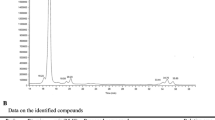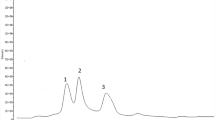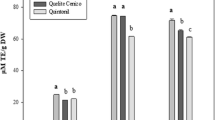Abstract
Nine summer season leafy greens viz., Amaranthus, bottle gourd, cucumber, jute, palak, poi, pumpkin, radish, water spinach, were evaluated for their antioxidants and mineral content at microgreen and mature stages. Among the antioxidants, total phenolics, total flavonoids, and ascorbic acid were quantified. Besides, antioxidant activities of the leafy vegetables were also measured using four in vitro assays viz., ferric reducing antioxidant power (FRAP), cupric reducing antioxidant power (CUPRAC), 2,2-diphenyl-1-picrylhydrazyl (DPPH), and Trolox equivalent antioxidant capacity assays (TEAC). In addition to this, the content of selected elements such as potassium (K), iron (Fe), manganese (Mn), zinc (Zn), and copper (Cu) was estimated. A wide variation was observed in the content of antioxidants and minerals. Variation was also observed for cultivar to cultivar as in case of Amaranthus. Results showed that the total phenolic content varied from 95.73 to 313.92 mg Gallic acid equivalent (GAE)/100 g in the mature vegetables, whereas the value varied from 25.00 to 152.10 mg GAE/100 g in microgreens. In fact, mature leafy vegetables were found to be significantly higher sources for total phenolics than microgreens. Likewise, a similar trend was observed for total flavonoids content and antioxidant activities. On the contrary, in all the species the concentration of K and Zn was significantly higher in microgreens than mature vegetables. However, no specific trend was observed in case of Fe, Cu, and Mn content. Based on antioxidant potentiality and mineral content, these leafy greens formed three distinct clusters; the first cluster represented by Amaranthus cv Local Green, jute, bottle gourd, and water spinach at mature stages. Jute was found to be the best, followed by bottle gourd, Amaranthus cv. Local Green, and water spinach.




Similar content being viewed by others
References
Apak R, Guclu K, Ozyurek M, Celik SE (2008) Mechanism of antioxidant capacity assays and the CUPRAC (cupric ion reducing antioxidant capacity) assay. Microchim Acta 160:413–419
Benzie IFF, Strain JJ (1996) The ferric reducing ability of plasma (FRAP) as a measure of antioxidant power: the FRAP assay. Anal Biochem 239:70–76
Brand-Williams W, Cuvelier ME, Berset C (1995) Use of free radical method to evaluate antioxidant activity. Lebensm Wiss Technol 28:25–30
Ebert AW, Wu TH, Yang RY (2015) Amaranth sprouts and microgreens—a homestead vegetable production option to enhance food and nutrition security in the rural-urban continuum. In: Sustaining small-scale vegetable production and marketing systems for food and nutrition security, Bangkok, pp 233–244
Kaur C, Kapoor HC (2002) Anti-oxidant activity and total phenolic content of some Asian vegetables. Int J Food Sci Technol 37(2):153–161
Koley TK, Singh S, Khemariya P, Sarkar A, Kaur C, Chaurasia SNS, Naik PS (2014) Evaluation of bioactive properties of Indian carrot (Daucus carota L.): a chemometric approach. Food Res Int 60:76–85
Koley TK, Maurya A, Singh B (2016) Microgreens from vegetables: more nutrition for better health. New Age Protect Cult 2(2):25–27
Koley TK, Singh S, Prasad RN, Singh B (2016) Microgreens are new generation smart food. Indian Hortic 61(1):3–4
Kopsell DE, Kopsell DA, Sams CE, Barickman TC (2013) Ratio of calcium to magnesium influences biomass, elemental accumulations, and pigment concentrations in kale. J Plant Nutr 36:2154–2165
Maathuis FJM, Diatloff E (2013) Roles and functions of plant mineral nutrients. In: Maathuis FJM (ed) Methods in molecular biology. Springer, New York, pp 1–21
Marinova D, Ribarova F, Atanassova M (2005) Total phenolics and total flavonoids in Bulgarian fruits and vegetables. J Univ Chem Technol Metal 40(3):255–260
Mensah JK, Okoli R, Ohaju OJO, Eifediyi K (2008) Phytochemical, nutritional and medical properties of some leafy vegetables consumed by Edo people of Nigeria. Afr J Biotechnol 7(14):2304–2309
Metson AJ (1956) Methods of chemical analysis for soil survey samples, vol 12. Department of Scientific and Industrial Research, Wellington
Pinto E, Almeida AA, Aguiar AA, Ferreira IM (2015) Comparison between the mineral profile and nitrate content of microgreens and mature lettuces. J Food Compos Anal 37:38–43
Re R, Pellegrini N, Proteggente A, Pannala A, Yang M, Rice Evans C (1999) Antioxidant activity applying an improved ABTS radical cation decolourization assay. Free Radic Biol Med 26:1231–1237
Sharma P, Ghimeray AK, Gurung A, Jin CW, Rho HS, Cho DH (2012) Phenolic contents, antioxidant and α-glucosidase inhibition properties of Nepalese strain buckwheat vegetables. Afr J Biotechnol 11(1):184–190
Singh UM, Sareen P, Sengar RS, Kumar A (2013) Plant ionomics: a newer approach to study mineral transport and its regulation. Acta Physiol Plant 35:2641–2653
Singleton VL, Orthofer R, Lamuela-Ranventos RM (1999) Analysis of total phenols other oxidation substrates and antioxidants by means of Folin–Ciocalteu reagent. Method Enzymol 299:152–178
Sun JH, Xiao ZL, Lin LZ, Lester GE, Wang Q, Harnly JM, Chen P (2013) Profiling polyphenols in five brassica species microgreens by UHPLC-PDA-ESI/HRMSn. J Agric Food Chem 61(46):10960–10970
Waterland NL, Moon Y, Tou JC, Kim MJ, Pena-Yewtukhiw EM, Park S (2017) Mineral content differs among microgreen, baby leaf, and adult stages in three cultivars of Kale. Hort Sci. 52(4):566–571
Xiao ZL, Lester GE, Luo YG, Wang Q (2012) Assessment of vitamin and carotenoid concentrations of emerging food products: edible microgreens. J Agric Food Chem 60(31):7644–7651
Yadav RK, Kalia P, Kumar R, Jain V (2013) Antioxidant and nutritional activity studies of green leafy vegetables. Int J Agric Food Sci Techol 4:707–712
Zhishen J, Mengcheng T, Jianming W (1999) The determination of flavonoid contents in mulberry and their scavenging effects on superoxide radicals. Food Chem 64:555–559
Acknowledgements
This research is supported by the Indian Council of Agricultural Research, Government of India.
Author information
Authors and Affiliations
Contributions
TKK: Planning of experiment, statistical analysis and manuscript writing. LPY: Growing of plant and biochemical analysis. AT: Biochemical analysis. SS: Mineral analysis
Corresponding author
Rights and permissions
About this article
Cite this article
Yadav, L.P., Koley, T.K., Tripathi, A. et al. Antioxidant Potentiality and Mineral Content of Summer Season Leafy Greens: Comparison at Mature and Microgreen Stages Using Chemometric. Agric Res 8, 165–175 (2019). https://doi.org/10.1007/s40003-018-0378-7
Received:
Accepted:
Published:
Issue Date:
DOI: https://doi.org/10.1007/s40003-018-0378-7




